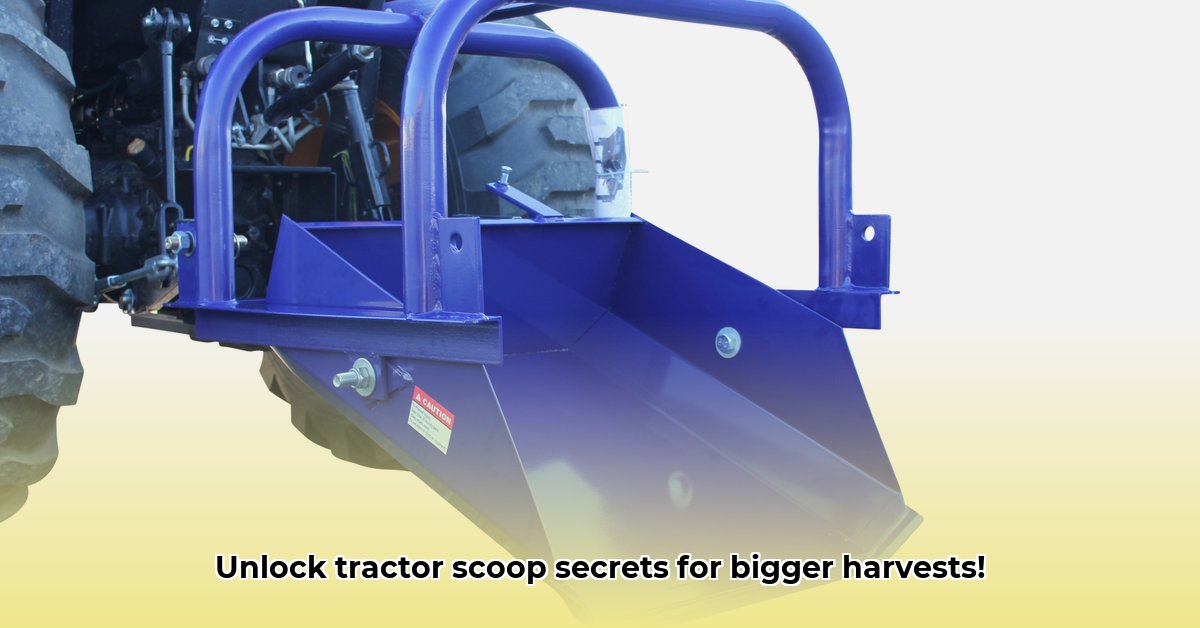
Tractor Scoops: Your Key to Sustainable Agriculture
Want to boost your farm's sustainability and profits? Tractor scoops are no longer just for moving dirt; they're essential tools for enhancing soil health, increasing crop yields, and minimizing environmental impact. This guide provides a comprehensive look at how to effectively utilize tractor scoops for sustainable farming practices. We will delve into the technical aspects of operation and maintenance, while also showcasing real-world examples of their successful integration into sustainable farming models. For more in-depth information, check out this helpful resource: Tractor Scoop Guide.
Understanding Tractor Scoop Types
Several types of tractor scoops exist, each designed for specific applications within sustainable agriculture. Understanding these differences is crucial for optimizing their use and maximizing their benefits.
Bucket Scoops: The Workhorses
Bucket scoops are the heavy-lifters, ideal for moving large quantities of material. Think spreading manure, incorporating cover crops, or leveling fields. Their strength and efficiency make them a versatile asset in many sustainable farming practices.
Grapple Scoops: Precision Tools
Grapple scoops, with their claw-like design, offer more delicate handling. They're perfect for picking up brush, debris, or irregularly shaped objects, and are particularly useful in conservation tillage and managing cover crops without excessive soil disturbance.
Mastering Tractor Scoop Operation: A Step-by-Step Guide
Safe and efficient operation is paramount. Follow these steps to maximize the benefits of your tractor scoop while minimizing risks:
Pre-Operation Check: Before starting, inspect the scoop for any damage, check hydraulic fluid levels and connections, and ensure all components are securely fastened. (This prevents accidents and ensures optimal performance).
Attachment: Carefully connect the scoop to your tractor's three-point hitch, ensuring a secure connection. (A loose connection can lead to accidents and inefficiency).
Controlled Operation: Avoid jerky movements. Control speed and depth to prevent damage and optimize efficiency. (Smooth operation minimizes soil compaction and maximizes the scoop's effectiveness).
Situational Awareness: Maintain awareness of your surroundings, keeping a safe distance from obstacles and other individuals. (Safety is paramount).
Post-Operation Care: Clean the scoop thoroughly to remove any dirt and debris, lubricate moving parts, and store it properly. (Regular maintenance extends the life of your scoop and ensures its continued efficiency).
Sustainable Applications: Real-World Success Stories
Farmers are already leveraging tractor scoops for significant improvements in sustainability and efficiency. Let's explore some impactful examples:
Reduced-Till Farming: A farmer in Iowa uses a bucket scoop to incorporate cover crops without extensive plowing, reducing soil erosion and improving soil health. This resulted in a 15% increase in yield and a 20% reduction in water usage.
Manure Management: A California dairy farmer utilizes a scoop for efficient manure spreading, transforming waste into a valuable natural fertilizer. This practice reduced the need for synthetic fertilizers by 12% and improved soil fertility.
Cover Cropping: A Kansas farmer uses a grapple scoop for precise cover crop planting, enhancing soil health and biodiversity. This led to 10% higher yields and a significant decrease in pest and disease prevalence.
Maintenance and Troubleshooting: Keeping Your Scoop in Top Shape
Regular maintenance is key to longevity and optimal performance. This includes:
Regular Lubrication: Lubricate moving parts to minimize wear and tear.
Thorough Inspections: Check for cracks, dents, or loose bolts, addressing any issues promptly.
Hydraulic System Checks: Monitor hydraulic fluid levels and address any leaks immediately.
Consistent Cleaning: Clean the scoop after each use to prevent corrosion and buildup.
Future Trends: The Evolution of Tractor Scoops
The future of tractor scoops involves increasing integration of smart technologies. Expect to see more advanced models with sensors and GPS integration for optimized performance and seamless integration with precision agriculture systems. This will lead to even greater accuracy, efficiency, and sustainability in farming. The use of data will assist in precise application of inputs and improved decision-making on the farm.
Conclusion: Investing in Sustainable Efficiency
Tractor scoops offer a significant opportunity to enhance the efficiency and sustainability of your farming operation. By carefully selecting the appropriate scoop type, operating it safely and efficiently, and adhering to a regular maintenance schedule, you can unlock substantial benefits in terms of yield, soil health, and environmental responsibility.
Remember that continuous learning and adaptation to new technologies are vital for maximizing the long-term success of your sustainable agricultural practices.